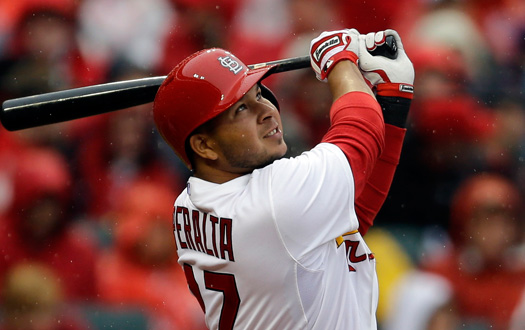
I reviewed long-term free agent deals (7-10 years) last week, and today I’ll examine last off-season’s mid-term deals (4-6 years) highlighted by the Cards’ Jhonny Peralta.
The Mets are close to turning a pivotal corner in the return to relevancy with a wealth of power pitching no less than a year away from being fully realized. Bartolo Colon was brought in to fill a portion of the black hole left by Matt Harvey who succumbed to a torn UCL injury, but anything behind Colon’s two year contract made little sense for the Mets in the long run.
The position players available to the club were former Yankees outfielder Curtis Granderson, former Tigers shortstop Jhonny Peralta, former Braves catcher Brian McCann and former Tigers second baseman Omar Infante. The Mets anticipated a breakout season from their top catching prospect Travis d’Arnaud, so McCann made little sense at five years and $85 million. The organization’s deepest position, aside from pitching, is second base with Wilmer Flores and Dilson Herrera both waiting behind All-Star Daniel Murphy, so Infante was never a fit either.
Peralta had the best season of any mid-level free agent signed last offseason. He ended the year by posting a career high 5.4 WAR and quieted the critics who questioned whether he was worth the four year, $53 million deal that the Cardinals jumped to offer him. The majority of teams were hesitant to commit that amount of time and money to a 32-year old shortstop coming off a 50 game PED suspension, but St. Louis had faith in a different approach than the rest of the league and it certainly paid off.
The Mets instead signed former Yankee’s slugger Curtis Granderson, 33, to a similar four year, $60 million deal. This satisfied a portion of the fan base that felt increased spending would hurdle the team into contention. The minority view among the fans was that Granderson, despite having a successful career, would not regain his stroke in Citi Field after an injury shortened season a year before. In the months of May, June, July and September, Curtis had 376 at bats, which represented more than 65% of his season total. His produced a .272/.370/.860 slash line, along with 18 homers and 54 RBI. The remaining 35% of the season (March, April, August), Curtis hit just .142/.241/.439. The net result provided little value this season, but came with promising anecdotes headed into 2015.
Back in July, Dave Cameron of FanGraphs said this of advanced metrics: At times, they’re flawed, but oftentimes they discover outliers in the data, or exceptions to conventional rules.
A concern regarding Peralta last offseason was his defense. Scouts who studied Peralta in the field felt that his range was limited and his lower body was too bulky, therefore defensive metrics in favor of the shortstop were inaccurate. However, Cameron argued that metrics that support Peralta, like Ultimate Zone Rating (UZR), are indeed accurate.
The stat line highlights him as an outlier, who replicated quality seasons on multiple occasions, despite the cautions of conventional wisdom. Although written in July, the predictions held true as Peralta ended the regular season fourth among all qualified shortstops in UZR (12) and UZR/150 (12.7).
Wilmer Flores didn’t play enough games to qualify at shortstop, but his performance measured by UZR/150 ranked him 5th among those that did, with Ruben Tejada coming in at 7th. The point being that, the same standards that deem Peralta a good shortstop, ranked our boys right behind him, so the Mets lost very little defensively by passing. The story at the plate turns into in an entirely different narrative with Peralta, especially if he was chosen instead of Granderson.
Offensively, Peralta was 2nd among qualified shortstops in home runs (21), RBI (75), slugging percentage (.443) and OPS (.779). According to ESPN’s Home Run Tracker, at least 18 of his 21 homers went beyond Citi Field’s dimensions, so his long ball power would have translated well to Queens. By comparison at shortstop, Jhonny still outperformed his counterparts on the Mets in almost every offensive category, combined. He also accomplished this in 86 fewer at-bats. Per his season totals, Peralta hit 10 more home runs, 11 more doubles and 30 more singles than the Mets contingent. In that same comparison, Peralta’s isolated slugging percentage (.179), or ISO, was 48.2% higher than the Mets shortstop unit (.093).
Had the Mets chosen Peralta instead of Granderson, it would have had a huge impact on the makeup of the outfield and the team’s performance in 2014. By August, a combination of Matt den Dekker, Juan Lagares and Kirk Nieuwenhuis would have been patrolling the outfield grass together. Not long ago, those three were the top center field prospects in the Mets minor league system. Given a full season together, it’s possible they may have developed into one of the best defensive units in baseball. Oftentimes rare, unforeseen circumstances, present opportunities to a combination of players who otherwise may never have discovered their talents as a unit.
Through 27 games in LF, den Dekker batted .295 with a .404 on base percentage. The home run ball eluded him, but he showcased his ability to spray doubles around the park and found ways to keep the line moving. His 26 hits, 8 doubles, 4 stolen bases, 15 walks and 17 runs brought tremendous value during that span. Translated into a 150 game season, that pace is good for 144 hits, 44 doubles and 94 runs scored.
Kirk played 17 games between right and center, where he’s far more comfortable, and hit .288/.371/.909 with 7 doubles, 2 home runs and 12 RBI. This year, the Mets played two full games with an outfield of den Dekker (LF), Lagares (C) and Nieuwenhuis (RF). The first was on 8/31 against the Phillies and the second was on 9/3 versus the Marlins. The Mets won both of those games decidedly, on the backs of that very outfield unit, who either scored or batted in 5 of the team’s 10 runs in those games. Together, over those 18 innings, they put up a collective slash line of .667/.769/1.991.
In the short run, Peralta was a huge miss on behalf of the Mets. He would have been an added threat in the lineup and his presence in lieu of Curtis may have altered the fate of the outfield. In the long run, signing Curtis could also prove harmless. Kirk has likely earned a spot on the bench after his stellar campaign as a pinch hitter and den Dekker still has an opportunity to win a starting corner outfield spot.
Sandy Alderson knew what Peralta could bring to the Mets. He personally met with him in the offseason and the only other player he met personally was Granderson. But the Mets’ GM likely believed a more elite player at a lower cost was available heading into next season. Few GM’s have the patience and conviction to sit out a full year in order to achieve their ultimate goal of winning a World Series, but the Mets are a unique team defined by big market expectations and a small payroll. Alderson saw 2014 as another year to evaluate the players he’s targeted as options and his own players he’d consider dangling.
As always, I look for feedback from other fans, what’s your take? Was Peralta the right shortstop for the Mets short and mid-term plans? Should Alderson have followed his initial instincts when he viewed Peralta as a key Mets target? Or was Granderson at a year older the right call for the future of the team? Or should he have passed on both of them?















